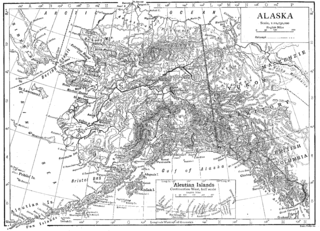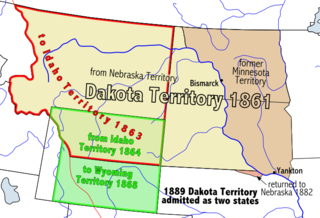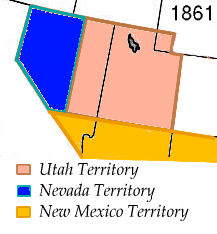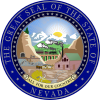
The Territory of Colorado was an organized incorporated territory of the United States that existed from February 28, 1861, until August 1, 1876, when it was admitted to the Union as the State of Colorado.

Since Utah became a U.S. state in 1896, it has sent congressional delegations to the United States Senate and United States House of Representatives. Each state elects two senators to serve for six years. Before the Seventeenth Amendment in 1913, senators were elected by the Utah State Legislature. Members of the House of Representatives are elected to two-year terms, one from each of Utah's four congressional districts. Before becoming a state, the Territory of Utah elected a non-voting delegate at-large to Congress from 1850 to 1896.

The 1860 and 1861 United States House of Representatives elections were held at various dates in different states from August 1860 to October 1861.

The 36th United States Congress was a meeting of the legislative branch of the United States federal government, consisting of the United States Senate and the United States House of Representatives. It met in Washington, D.C. from March 4, 1859, to March 4, 1861, during the third and fourth years of James Buchanan's presidency. The apportionment of seats in the House of Representatives was based on the Seventh Census of the United States in 1850. The Senate had a Democratic majority, and the House had a Republican plurality.

The 38th United States Congress was a meeting of the legislative branch of the United States federal government, consisting of the United States Senate and the United States House of Representatives. It met in Washington, D.C. from March 4, 1863, to March 4, 1865, during the last two years of the first administration of U.S. President Abraham Lincoln. The apportionment of seats in the House of Representatives was based on the Eighth Census of the United States in 1860. The Senate had a Republican majority, and the House of Representatives had a Republican plurality.

The 37th United States Congress was a meeting of the legislative branch of the United States federal government, consisting of the United States Senate and the United States House of Representatives. It met in Washington, D.C. from March 4, 1861, to March 4, 1863, during the first two years of Abraham Lincoln's presidency. The apportionment of seats in the House of Representatives was based on the Seventh Census of the United States in 1850.
Nevada's 2nd congressional district is a congressional district that includes the northern third of the state. It includes most of Lyon County, all of Churchill, Douglas, Elko, Eureka, Humboldt, Lander, Pershing, Storey, and Washoe counties, as well as the state capital, Carson City. The largest city in the district is Reno, the state's third largest city. Although the district appears rural, its politics are dominated by Reno and Carson City. As of 2017, over 460,000 people reside in Washoe County alone, totaling about two-thirds of the district's population.
Pennsylvania's fourth congressional district, effective January 3, 2019, encompasses the majority of Montgomery County and a small sliver of Berks County in southeastern Pennsylvania, and is represented by Democrat Madeleine Dean. From 2013 to 2018, the district was in the south-central part of the state, covering all of Adams and York counties, as well as parts of Cumberland and Dauphin counties, with representation by Republican Scott Perry.

Alaska Territory's at-large congressional district was a congressional district created in 1906 to represent the District of Alaska, which was reorganized into the Alaska Territory in 1912. After Alaska's admission to the Union as the 49th state by act of Congress on January 3, 1959, this district evolved into Alaska's at-large congressional district.

California's 39th congressional district is a congressional district in the U.S. state of California. The district includes parts of Los Angeles, Orange and San Bernardino counties, and includes Fullerton, La Habra, La Habra Heights, Brea, Buena Park, Anaheim Hills, Placentia, Yorba Linda, Diamond Bar, Chino Hills, Hacienda Heights and Rowland Heights. Since 2021, it has been represented by Republican Young Kim.

Dakota Territory's at-large congressional district is an obsolete congressional district that encompassed the entire Dakota Territory prior to admission to the Union. The district elected a delegate to the United States Congress.

Oregon Territory's at-large congressional district is an obsolete congressional district that encompassed the area of the Oregon Territory. In 1853, the northern half of the territory was reorganized into the Washington Territory.

Hawaii Territory's at-large congressional district was the congressional district for the Territory of Hawaii, which was established by the Newlands Resolution of 1898.
The Territory of Colorado was represented by one non-voting delegate at-large to the United States House of Representatives from its organization in 1861, until statehood in 1876.

Iowa Territory's at-large congressional district is an obsolete congressional district that encompassed the area of the Iowa Territory, which was split off from the Wisconsin Territory in 1838. After Iowa's admission to the Union as the 29th state by act of Congress on December 28, 1846, this district was dissolved and replaced by Iowa's at-large congressional district.

Idaho Territory's at-large congressional district is an obsolete congressional district that encompassed the area of the Idaho Territory, which was originally created from parts of the Washington Territory and Dakota Territory in 1863. In 1864, parts of the territory were ceded back to the Dakota Territory and another part was reorganized into the Montana Territory. The boundaries of the territory were changed again in 1868 when the Wyoming Territory was created.

New Mexico Territory's at-large congressional district is an obsolete congressional district representing the New Mexico Territory, which was created in 1850. After New Mexico's admission to the Union as the 47th state by act of Congress on January 6, 1912, this district was dissolved and replaced by New Mexico's at-large congressional district.

Wyoming Territory's at-large congressional district is an obsolete congressional district that encompassed the area of the Wyoming Territory. After Wyoming's admission to the Union as the 44th state by act of Congress on July 10, 1890, this district was dissolved and replaced by Wyoming's at-large congressional district.
Nevada's 4th congressional district is a congressional district that was created as a result of the 2010 United States Census. Located in the central portion of the state, it includes most of northern Clark County, southern Lyon County and all of Esmeralda, Lincoln, Mineral, Nye and White Pine counties.

The 1911 United States House of Representatives election in New Mexico was held on November 7, 1911, in anticipation of the admission of the state of New Mexico. Two representatives were elected to the at-large congressional district on a single ballot. This election took place during the 62nd Congress; the winners were seated on January 8, 1912.


















